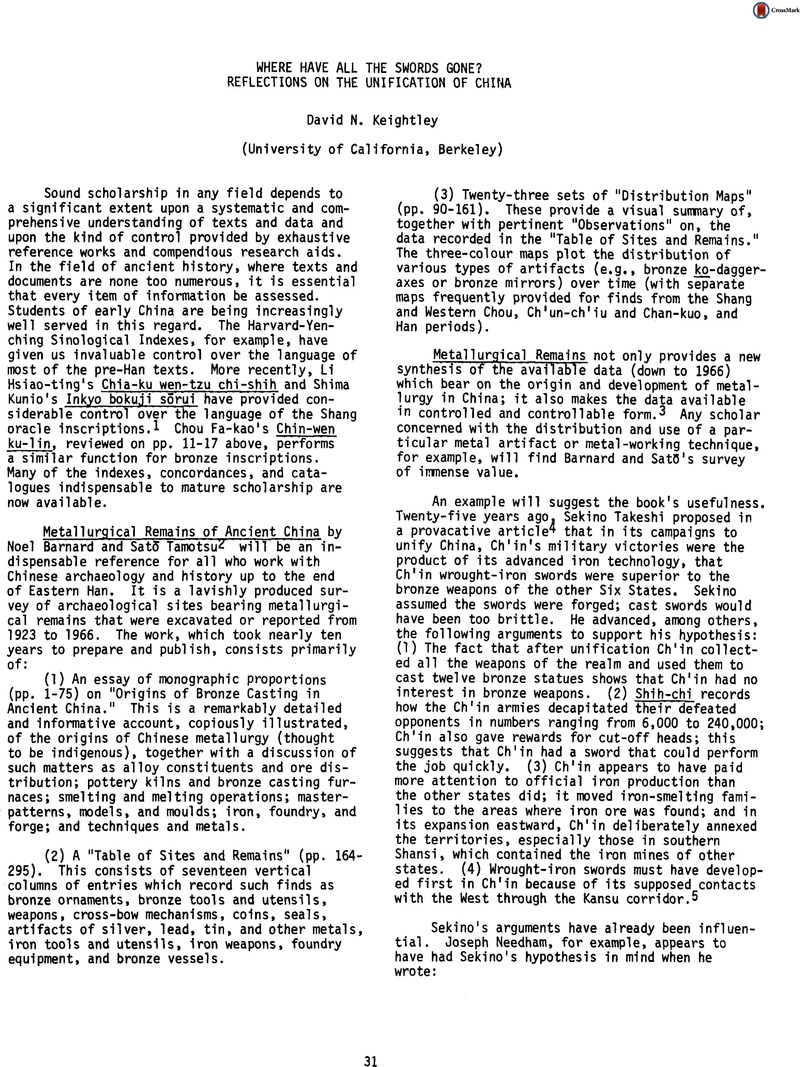Article contents
Where Have All the Swords Gone? Reflections on the Unificationof China
Published online by Cambridge University Press: 26 March 2015
Abstract

- Type
- Review Articles
- Information
- Copyright
- Copyright © Society for the Study of Early China 1976
References
FOOTNOTES
1. For an introduction to these works, see my review in Monumenta Series 37 (1969), pp. 467–471 Google Scholar.
2. Barnard, Noel and Tamotsu, Satō, Metallurgical Remains of Ancient China (Tokyo, 1975)Google Scholar. Large format: 15 × 12 ins (37.5 × 30.0 cm); i-xxxii, 1-343. Frontispiece, 3 Plates (three in colour, one in collotype), 55 Figures, 6 Tables, 26 sets of Maps (three-colour off-set), “Table of Sites and Remains,” Indexes, Bibliography.
3. Metallurgical Remains and Kwang-chih, Chang, Shang-Chou ch'ing-t'ung-ch'i yü ming-wenti tsung-ho yen-chin (reviewed on pp. 11–17 above)Google Scholar complement each other. The fact that Changes data have been recorded on punch cards means that scholars may obtain rapid answers from his material. In the case of Metallurgical Remains, by contrast, a visual check of the tables is still necessary to extract, for example, some pattern of geographical or chronological distribution (to the extent that the maps do not already do this). One wonders if it would be worthwhile coding Barnard and Sato's tables and placing them on cards?
4.
Takeshi, Sekino
![]() , “Chūgoku shoki tekki bunka no
ikkōsatsu--dōtetsu katoki no toki kaimei ni yosete”
, “Chūgoku shoki tekki bunka no
ikkōsatsu--dōtetsu katoki no toki kaimei ni yosete”
![]()
![]()
![]() (An investigation into China's earliest iron
implement culture: towards an interpretation of the bronze-iron
transition), Shigaku zasshi
(An investigation into China's earliest iron
implement culture: towards an interpretation of the bronze-iron
transition), Shigaku zasshi
![]() 60, no. 10 (10
1951), pp. 867–907
Google Scholar. Reprinted, with photographs of iron objects in
Takeshi, Sekino,
Chūgoku kōkogaku kenkyū
60, no. 10 (10
1951), pp. 867–907
Google Scholar. Reprinted, with photographs of iron objects in
Takeshi, Sekino,
Chūgoku kōkogaku kenkyū
![]() (Tokyo,
1963), pp. 159–221
Google Scholar.
(Tokyo,
1963), pp. 159–221
Google Scholar.
5. Sekino (1951), pp. 869-879.
6. Needham, Joseph, Science and Civilisation 1n China: Volume 2: History of Scientific Thought (Cambridge, Eng., 1956), p. 215 Google Scholar.
7. With regard to item (2), for example, the anti-Ch'in bias of the written sources has to be considered. And I cannot refrain from referring to A. Conan Doyle's “The Adventure of Black Peter,” in which Sherlock Holmes returns from Allardyce's butcher shop with “a huge barb-headed spear tucked like an umbrella under his arm.” “I have satisfied myself,” he explains to Watson, “that by no exertion of my strength can I transfix…with a single blow” the dead pig which was hung there. Similar grisly experiments may be required to test the “decapitation efficiency” of bronze or iron swords. Sekino's study of shape and hardness [1951], (p.873) indicates the work that needs to be done, but as he notes (p. 901, n. 16), the hardness tests were performed on Japanese iron swords, the Chinese ones being too rusty.
8. Note that Map 6 (p. 113), which plots the general distribution of bronze and iron swords from Ch'un-ch'iu to Eastern Han times, contains errors; these have been corrected in the separate overlay provided by the publishers.
9. Metallurgical Remains, p. 112.
10. As for the Chan-kuo sword from Shantung (site 2), the entry at Table 12:22?,
the Chan-kuo tomb at Chi-nan ![]() , records no
iron swords at all. though it does indicate one bronze sword (col. 3) was
found at the siteo Either the map or the table seems to be wrong in this
case.
, records no
iron swords at all. though it does indicate one bronze sword (col. 3) was
found at the siteo Either the map or the table seems to be wrong in this
case.
11. Answers to the kind of questions raised in this review will require detailed historical study of military geography (to tell us when certain areas beyond Shensi came under Ch'in control, for example) and a more precise dating of the individual finds than may frequently be possible. For an example of the kind of study needed, see Wen-wu 1976.6: 82–85 Google Scholar, which discusses the style and date of several bronze ko-daggers found in Szechwan and which concludes that one such dagger-axe, excavated from a tomb in 1972, was not imported but was made in Szechwan, and that it may be dated, from its inscription, to 221 B.C. The kind of information about campaigns recorded in the Ch'in dynasty bamboo strips excavated in Yünmeng In December 1975 (see, in particular, Wen-wu 1976.5: 2–3 Google Scholar; 1976,7:14) may also be of use.
- 5
- Cited by


